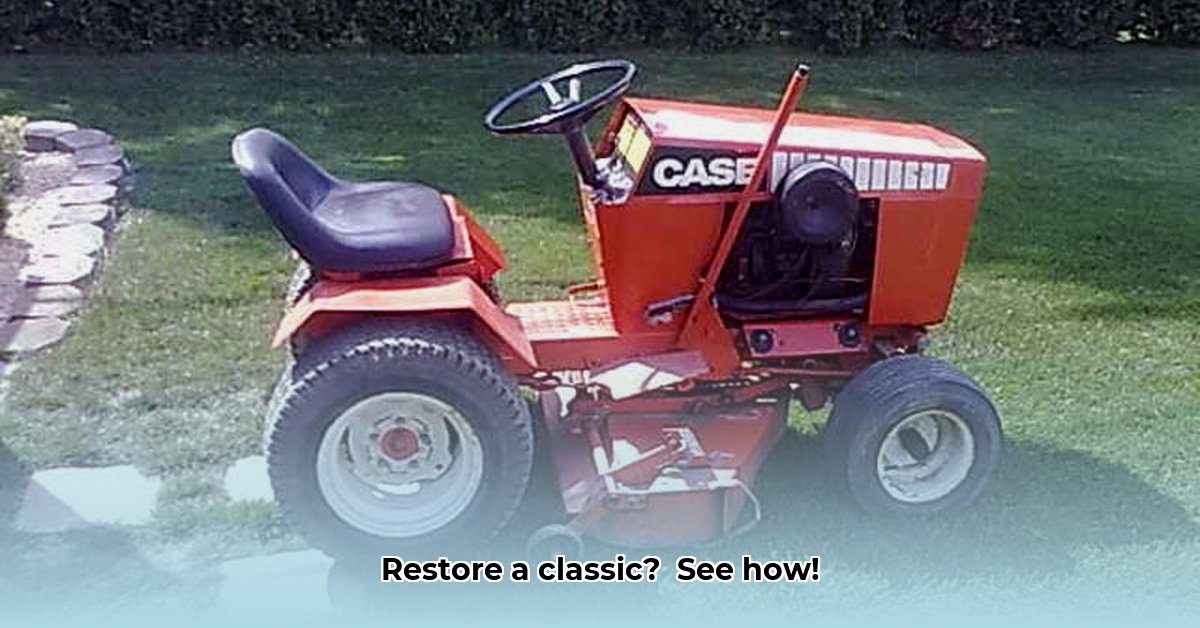
A Blast from the Past: The J.I. Case 220
The J.I. Case 220 garden tractor, manufactured from 1968 to 1988 in Winneconne, Wisconsin, represents a bygone era of robust, dependable machinery. Its distinctive design and the satisfying rumble of its Kohler K241AS engine (a workhorse in its time) have made it a sought-after classic among collectors and enthusiasts. This guide offers a comprehensive restoration roadmap, blending historical context with practical, step-by-step instructions. Are you ready to revitalize a piece of agricultural history? For more information on similar Case tractors, check out this helpful resource.
Understanding Your Case 220: Technical Specifications and History
Before embarking on your restoration journey, understanding the Case 220's technical specifications and historical context is crucial. This 10-12 horsepower machine typically features a smooth-running hydrostatic transmission. However, you should verify the precise engine specifications using original brochures or service manuals (often found online or through vintage tractor parts suppliers). These manuals are invaluable resources, providing detailed insights into the tractor's design and operation – a critical foundation for restoration. Finding original documentation allows you to truly understand the engineering nuances of the machine.
Essential Maintenance for a Long-Lasting Case 220
Regular maintenance is paramount for preserving your Case 220. Preventative care is key to preventing costly repairs down the line. Think of it as preventative medicine for your mechanical friend.
Engine Care: Regular oil changes (using the correct weight specified in your owner's manual) are non-negotiable. Clean or replace the air filter frequently. Diligent inspection for oil leaks is also critical. Neglecting these steps can lead to significant engine damage. Isn't the preventative care worth it to avoid a major overhaul?
Transmission Tune-Up: The hydrostatic transmission, while durable, requires regular fluid checks and occasional fluid changes. Using the correct transmission fluid is crucial. Failure to do so can lead to premature wear and costly repairs.
Brakes: Safety First: Regularly inspect and adjust the band brakes. These are vital for safety. Given the age of these machines, sourcing replacement parts can be a challenge – make preservation a priority.
Hydraulic System Check: Carefully monitor the hydraulic system for leaks. Addressing leaks promptly prevents further damage. Consulting your owner's manual or experienced Case 220 owners is advisable since hydraulic systems are complex.
Electrical System Inspection: Regularly inspect all wiring for damage. Preventing electrical issues prevents potentially dangerous situations and downtime.
The Parts Pursuit: Sourcing Components for Your Restoration
Finding parts for a vintage machine can be a challenge. However, many resources are available to assist you.
- Online Forums: Dedicated Case tractor forums, like CaseColtingersoll, are invaluable resources, connecting you with a vast network of enthusiasts. These communities are excellent sources of parts leads, advice, and troubleshooting assistance.
- Dealers: Contact Case equipment dealers. They might have NOS (new old stock) parts. It's worth making some phone calls.
- Junkyards: Local junkyards can be a source of parts, but be prepared to invest time and possess a keen eye.
Remember, the most crucial elements are diligence and patience.
Restoring Your Case 220: A Step-by-Step Guide
Restoring a Case 220 is a rewarding project, but it demands patience and a methodical approach.
Disassembly: Begin by carefully disassembling the tractor, taking detailed photographs at each step. This photographic record is invaluable during reassembly.
Cleaning: Thoroughly clean each part, using appropriate solvents and brushes to remove grease and grime. A deep cleaning reveals the extent of damage or wear, informing your needed repairs.
Repair or Replace: Repair any parts you can. If beyond repair, source high-quality replacements. Investing in quality parts is critical for reliable operation.
Reassembly: Reassemble the tractor, referring to your photographic guide. Test each system individually to ensure correct functionality.
Finishing Touches: Apply a fresh coat of paint (if desired) and restore worn upholstery. This is your chance to personalize your restoration.
Addressing the Carburetor Conundrum: Ethanol's Impact
One common hurdle in Case 220 restoration is the carburetor. Ethanol-blended fuels often damage older carburetors. Careful cleaning might suffice, but a full rebuild is frequently necessary. Consider professional help if unsure. Using fuel stabilizer and non-ethanol fuel in the future is crucial.
Attachments and Accessories: Expanding Your Tractor's Capabilities
The Case 220's versatility is enhanced by its impressive range of attachments. Mowers, tillers, snow blowers—the possibilities are vast. However, finding original attachments can often prove as difficult as locating tractor parts.
Conclusion: The Rewards of a Successful Restoration
Restoring a J.I. Case 220 is a labor of love, combining technical skill with historical appreciation. While time-consuming and demanding, the satisfaction of bringing a piece of history back to life is immeasurable. The resulting machine becomes more than just a tractor; it becomes a testament to your dedication and a connection to a bygone era of engineering.